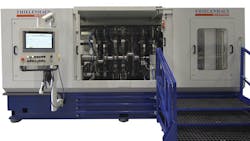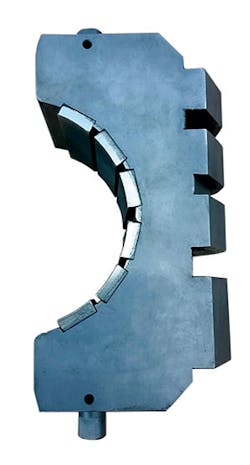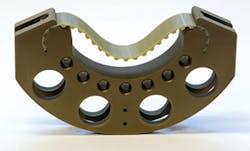Expanding the Possibilities for Microfinishing Crankshafts
Machine tools are not designed for forgers, necessarily, but perhaps they should be so: According to the 2017 FORGING Business Outlook Survey, 22.6% of North American forging operations plan to invest in new finish machining capability during the current year. Forgers know the value that finish machining may represent to their engineered products.
One common understanding that machine tool builders and forgers have is the part specifications that their prospective customers must achieve: higher-precision machining process capabilities; higher-precision finished forgings. In each case, automotive designs are the origin of that need for precision. An already high-value and high-precision automotive forging, a crankshaft, may become an opportunity for even more value with “micromachining” capability.
Crankshaft consist of a high-strength crank augmented with a series of carefully placed “throws” and other bearing surfaces with axes offset the throws, all positioned to engage connecting rods that receive the reciprocating motion of an engine’s pistons. It’s the crankshaft, and more specifically the crankshaft’s precision-engineered design, that makes it possible to convert reciprocating motion to rotating motion, and thus “drive” the engine.
But finishing forged crankshafts properly can be difficult – and critical to the finished part’s performance.
After evaluating statistics from its fleet, a commercial truck OEM ascertained that a high percentage of reported crankshaft damage results from particularly heavy loads on the bearings’ radii. Working with Thielenhaus Technologies, builders of machine tools, the truck maker decided to finish machine the bearings as well as on the transition radii.
In order to achieve the same surface quality on the crankshaft journals and radii, Thielenhaus developed a new “tape contact shoe,” the RadiusFlex. This new capability presses a finishing tape with a special profile on each side into the radius, allowing radii to be machined up to 90 degrees -- a significant increase in capability from the previous limit, 60 degrees.
Quicker, Easier, More Cost-Effective
The OEM was able to improve its microfinishing target, but this new technique and others, may present new possibilities for microfinished crankshafts of various designs, produced more quickly, easily, and cost-effectively than imagined.
The shoe systems can be integrated in Thielenhaus’s CrankStar machine platform, which features horizontal and vertical versions for machining passenger car or truck crankshafts and can be adjusted to the specific needs of each manufacturer. Based on requirements for part handling, cycle times, quality tolerances, part variations, and machining tasks, Thielenhaus offers to custom-develop machines that meet the microfinishing goals of the operator.
In order to achieve the standard roundness improvements on main and pin bearings, CrankStar employs pneumatic technology to counterbalance pin-bearing forces of +/- 5 Newtons. This ensures that the machining forces on the rotating crank pin are kept constant and that the mass forces that occur between the shoe and bearing are compensated. The roundness is thus improved to exactly the same extent on all bearings, whether pin or main bearings.
The standard design CrankStar is able to machine crankshafts for three- to six-cylinder engines, in some cases even without major retooling. In addition to center and pin bearings and thrust faces, the CrankStar can finish oil-seal diameters and deburr bores in the flange. Thrust face machining occurs via a special unit while the workpiece is oscillated.
The vertical version of the CrankStar achieves up to 33% longer than standard intervals between tool changes, with a tape capacity of 300+ meters. This vertical version allows a quick belt change from the front of the machine, without requiring the withdrawal of an entire tool carrier package.
Thielenhaus currently is developing prototypes and filing patent applications for several more tape contact shoe systems: In addition to the conventional hard or soft shoes, it promises to offer a shoe that uses a belt system that will adapt to a component’s size. This DiaFlex technology means that crankshafts with the same bearing widths but different diameters can be machined without swapping the shoes. In practice, due to higher torques in three- or four-cylinder motors, a few millimeters more of bearing diameter are needed with the same motor concept and gauge. The DiaFlex shoe adapts to the respective diameter and can compensate for differences of up to 15 mm without changing shoes.
The scope of this research reveals the opportunities that exist for forgers that adopt finish machining capability – and for machine tool developers that exploit the need for more focused and flexible microfinishing methods.


